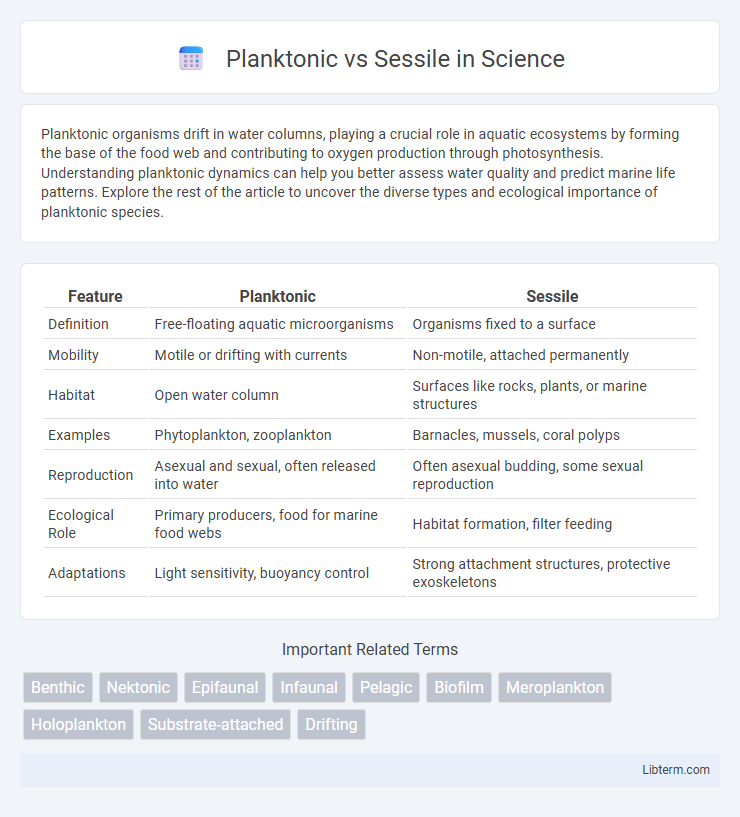Planktonic organisms drift in water columns, playing a crucial role in aquatic ecosystems by forming the base of the food web and contributing to oxygen production through photosynthesis. Understanding planktonic dynamics can help you better assess water quality and predict marine life patterns. Explore the rest of the article to uncover the diverse types and ecological importance of planktonic species.
Table of Comparison
| Feature | Planktonic | Sessile |
|---|---|---|
| Definition | Free-floating aquatic microorganisms | Organisms fixed to a surface |
| Mobility | Motile or drifting with currents | Non-motile, attached permanently |
| Habitat | Open water column | Surfaces like rocks, plants, or marine structures |
| Examples | Phytoplankton, zooplankton | Barnacles, mussels, coral polyps |
| Reproduction | Asexual and sexual, often released into water | Often asexual budding, some sexual reproduction |
| Ecological Role | Primary producers, food for marine food webs | Habitat formation, filter feeding |
| Adaptations | Light sensitivity, buoyancy control | Strong attachment structures, protective exoskeletons |
Introduction to Planktonic and Sessile Organisms
Planktonic organisms drift in aquatic environments, relying on water currents for movement and often comprising microscopic algae, bacteria, and small animals. Sessile organisms, such as barnacles, corals, and sponges, are fixed in one location, typically attaching to substrates like rocks or the ocean floor. Understanding the distinct lifestyles and adaptations of planktonic versus sessile organisms is essential for studying aquatic ecosystems and biodiversity.
Defining Planktonic Lifestyle
Planktonic lifestyle refers to organisms that drift or float freely in aquatic environments, often suspended in water columns without attachment to surfaces. These organisms exhibit adaptations for swimming or passive drifting, enabling dispersal and feeding in open waters. Planktonic species contrast with sessile organisms, which remain attached to substrates and rely on localized nutrient acquisition.
Characteristics of Sessile Organisms
Sessile organisms are characterized by their fixed position, often attaching permanently to substrates such as rocks, coral reefs, or aquatic plants. These organisms typically exhibit adaptations like strong holdfasts or adhesive structures to withstand currents and maximize nutrient absorption from their immediate environment. Sessile species also tend to have specialized feeding mechanisms, such as filter feeding, to efficiently capture food particles from the surrounding water.
Habitat and Environmental Adaptations
Planktonic organisms inhabit open water environments, relying on buoyancy adaptations such as oil droplets or gas vesicles to maintain position in the water column and optimize nutrient absorption. Sessile organisms are fixed to substrates in aquatic or terrestrial habitats, often developing robust attachment structures like holdfasts or byssal threads to withstand currents and environmental stressors. Both exhibit specialized physiological and morphological traits tailored to their distinct habitats, ensuring survival and reproductive success under varying environmental conditions.
Nutrient Acquisition and Feeding Strategies
Planktonic organisms acquire nutrients by absorbing dissolved organic matter and filtering small particles from the surrounding water, utilizing passive feeding strategies adapted to their mobile, suspended lifestyle. Sessile organisms rely on active feeding methods, such as filter feeding or symbiotic relationships with microorganisms, to capture nutrients from the immediate environment while remaining fixed to a surface. Differences in water flow and nutrient availability drive the evolutionary adaptations in feeding mechanisms between planktonic and sessile species.
Reproduction Methods and Life Cycles
Planktonic organisms primarily reproduce through sexual reproduction involving gamete release into the water column, facilitating wide dispersal of offspring during their relatively short and floating life cycles. Sessile organisms, such as barnacles and corals, often reproduce both sexually through broadcast spawning and asexually via budding or fragmentation, resulting in localized colonization and stability throughout their extended benthic life cycles. The contrasting reproduction methods and life cycles optimize survival strategies: planktonic species capitalize on dispersion and gene flow, while sessile species maximize resource use and habitat occupation.
Mobility and Dispersal Mechanisms
Planktonic organisms exhibit high mobility through passive drifting aided by water currents, enhancing their dispersal over vast aquatic environments. Sessile organisms remain attached to substrates, relying on limited dispersal mechanisms like releasing motile larvae or spores to colonize new areas. Mobility in planktonic forms contrasts sharply with the localized attachment strategies in sessile forms, influencing ecological distribution and population dynamics.
Ecological Roles and Ecosystem Impact
Planktonic organisms drift in aquatic environments, playing crucial roles in nutrient cycling and serving as primary producers or prey within the food web. Sessile organisms, anchored to surfaces, contribute to habitat formation, biofouling, and nutrient retention through filtration and substrate stabilization. Together, these lifestyles influence ecosystem dynamics by regulating energy flow, supporting biodiversity, and affecting water quality.
Advantages and Disadvantages of Each Lifestyle
Planktonic organisms benefit from greater dispersal potential and access to diverse nutrient sources but face higher predation risks and environmental fluctuations. Sessile organisms gain stability and efficient resource acquisition through substrate attachment but experience limited mobility and vulnerability to localized disturbances. Understanding these trade-offs aids in ecological and evolutionary studies of microbial survival strategies.
Evolutionary Perspectives on Planktonic vs Sessile Adaptations
Planktonic organisms exhibit evolutionary adaptations such as buoyancy control and streamlined bodies to maximize dispersal and resource acquisition in open water environments. Sessile organisms have developed traits like robust attachment structures and efficient nutrient absorption mechanisms to thrive in stable, resource-rich substrates. These divergent strategies reflect selective pressures favoring mobility and environmental exploitation in planktonic species versus stability and localized resource optimization in sessile species.
Planktonic Infographic

 libterm.com
libterm.com